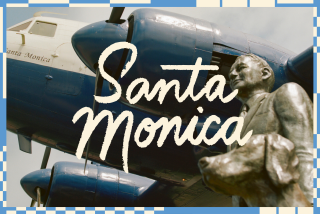WILLELLA HOWE-WAFFLE HOME AND CARRIAGE HOUSE
The Willella Howe-Waffle House in downtown Santa Ana has defied the odds for sheer existence as it celebrates its 100th anniversary this year. Its survival was neither likely nor probable: It took several stays of demolition by the wrecker’s ball, fund-raisers, even a banner nailed to the house pleading for foundation funds before preservationists won over condominium developers in the area.
The Howe-Waffle House, considered at the turn of the century one of Santa Ana’s showplaces, was built by Dr. Alvin Jared Howe, Santa Ana’s second mayor, and his wife, Willella Earhart, one of Orange County’s first woman physicians. The building, originally situated on the northwest corner of Bush and Seventh streets, was threatened by the street-widening project of
Civic Center Drive
and after numerous negotiations with City Hall was moved to its current location at the southeast corner of Civic Center Drive and Sycamore Street during March, 1975.
The restoration of this two-story gingerbread house, with its multigabled roof and turret tower, became a passion for Santa Ana resident Adeline Walker, who died in 1985 just before the project’s completion. In the mid-1970s, the house “was in a state of disrepair,” says Scott Morgan, chief executive assistant to Supervisor Roger Stanton. Walker, working with other volunteers, personally stripped away wallpaper (once discovering a covered window), stripped paint from the wood, even single-handedly planted a jacaranda tree in the yard, then furnished the house as it might have looked at the time of Dr. Howe-Waffle’s death in 1924. (The Santa Ana Historical Preservation Society was founded at Walker’s instigation and currently has 200 members.)
The house displays its original California redwood throughout its 12 rooms. At the entrance, the main staircase to the second story is made of beautifully carved wood. Lace curtains, in the style of the early ‘20s, border the bay windows. Dried flowers accent the rooms throughout the house.
The rugs in the parlor and family parlor room are bordered with a rose pattern that was a particular favorite of Dr. Willella’s, displaying Walker’s painstaking research; the revolving bookcase, in the family parlor, was returned by the family to complete the Howe-Waffle museum. Walls are covered with wallpaper popular in the 1910s and the ‘20s. The so-called Wisteria Room, named after its wallpaper pattern, holds an original washstand and dresser.
The fireplace in the
dining room has also been
there since the turn of the
century; the table is covered with a lace tablecloth. The kitchen retains its 1910 kitchen stove and a single-burner alcohol stove; the linoleum is a reproduction of a 1904 pattern.
“It took (10 years) till about 1985 to get it in
the shape it’s in now,” Morgan says.
The Santa Ana Historical Preservation Society’s early hope to develop a small medical museum containing suitable medical equipmentto honor the pioneer physician was scratched. The doctor’s medical instruments, including items labeled “forceps for delivering babies” and “needles and cat gut” appear in display cases or hang framed on the wall.
The house’s wraparound veranda is original; the gazebo, replacing what was once an aviary, was built by Max Becker, another member of the preservation society. The carriage house boasts three carriages such as those Dr. Howe-Waffle may have used to make house calls. (In earlier years she visited sick patients by horse and buggy.) Becker and Royal Spurrier, another society member, “have spent thousands of hours doing repair work, often six to eight hours every weekend,” Morgan says. “It’s all been a community effort.”
Diann Marsh, an active member of the Historical Preservation Society and a resident of Santa Ana’s French Park district, remembers Walker as having been very protective toward the house, wary of guests or visitors. The house’s restoration was her mission in the last decade of her life. Today Marsh says the home deserves a wide viewership; she “would like to share it with others.”
(Addendum: The marriage of Alvin and Willella led to divorce, after which Dr. Willella married Edwin D. Waffle, owner of a livery business. The prejudice that greeted a woman doctor in Orange County in the 19th Century was “as relentless as an Apache Indian,” Dr. Howe-Waffle is quoted as saying. But after she established her reputation, she is said to have delivered half the babies, known later as “Waffle babies,” born in Santa Ana’s growing population at the turn of the century.)
BHours: 10 a.m. to 1:30 p.m., Tuesdays; 11 a.m. to 2 p.m., third Saturday of each month
Address: 120 E. Civic Center Drive, Santa Ana
Telephone: (714) 547-9645
Miscellaneous information: There is no cost, but contributions are welcome. Guests to the Howe-Waffle House on the third Saturday of each month often visit it in tandem with an exploration of two other historical landmarks in the vicinity: the Episcopal Church of the Messiah (1888), at 614 N. Bush St., and the Old Orange County Courthouse (1901), 211 W. Santa Ana Blvd. To join the Santa Ana Historical Preservation Society, write to request an application for membership from 120 Civic Center Drive West, Santa Ana, Calif. 92701. Santa Ana residency is not required, simply an interest in history.
More to Read
Sign up for Essential California
The most important California stories and recommendations in your inbox every morning.
You may occasionally receive promotional content from the Los Angeles Times.






